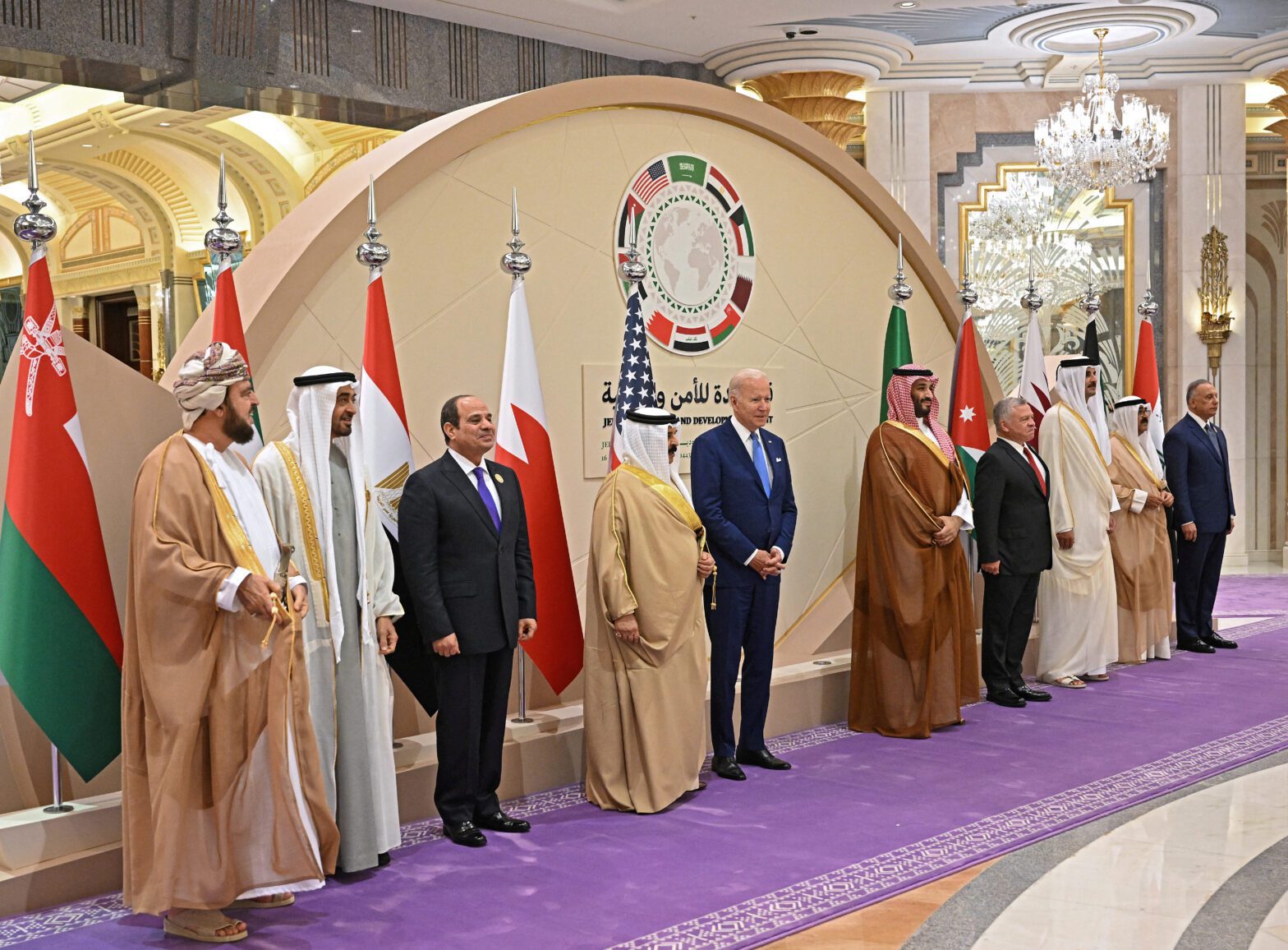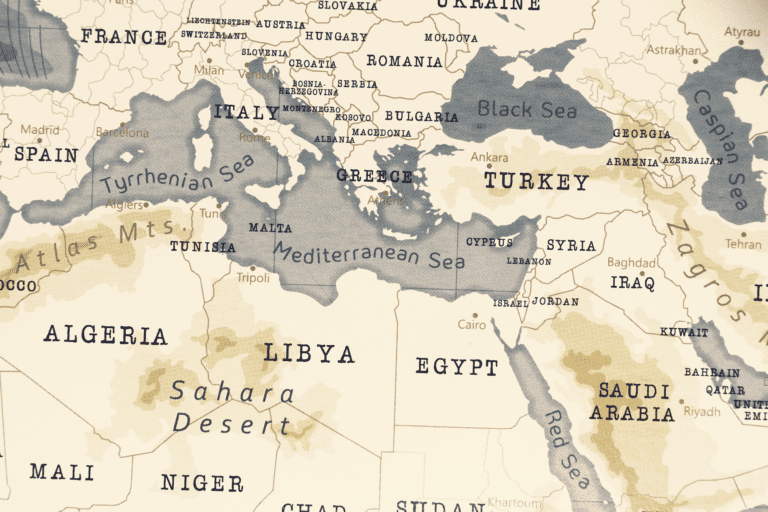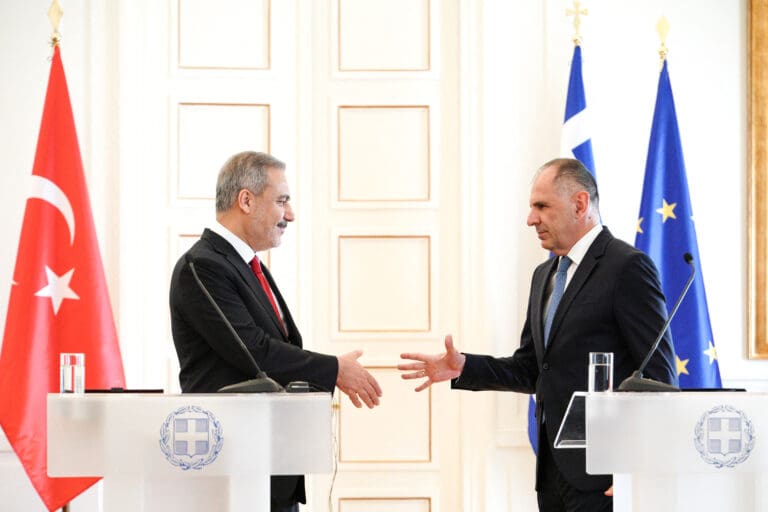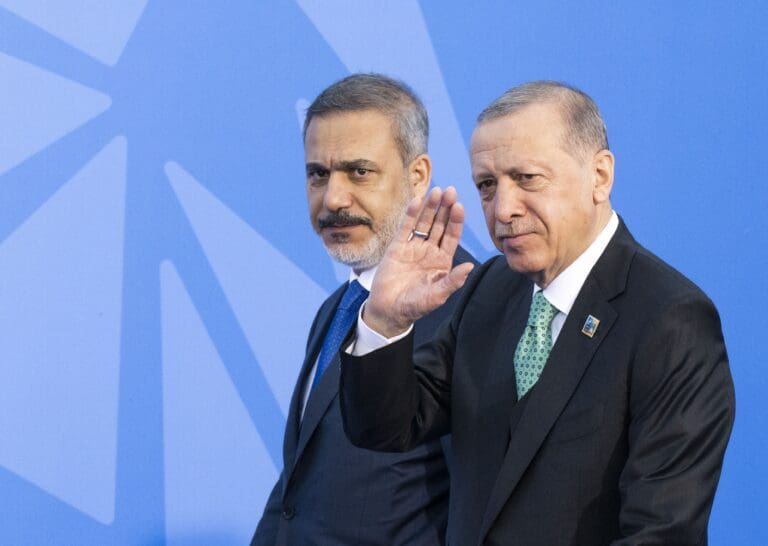
Middle East and the Future of International Politics
Issue Brief, December 2022
Key Takeaways
A Visionless Great Power Rivalry: Great power politics and competition form the overarching framework of global politics and have a significant impact on regional politics worldwide, including in the Middle East. However, thus far, this great power rivalry has been devoid of all-encompassing visions or political/ ideological projects.
Assertive Regional Powers: Regional powers have more agency and autonomy in shaping the course of their regional politics than in the past. They have become less amenable to the pressures of global actors.
Enabling Authoritarianism: During great power rivalries, geopolitical and security considerations take precedence over other concerns. Heightened focus on geopolitical and security concerns is damaging to the regional transformation process and democratization in the region and is likely to further reinforce regional authoritarianism.
Regional Fragmentation: Given that the Middle East is already a highly fragmented region, regional decision makers are at the helm of carefully managing the rivalry between the United States, Russia, and China to offset the potential of this competition leading to further regional fragmentation and discord.
After decades of unipolar world order, the return of great power competition has become a fact of global politics today. The North Atlantic Treaty Organization’s (NATO) new Strategic Concept document, released in June 2022, clearly illustrates how the organization is preparing itself for a new international security environment defined by such a competition.1 During the Cold War, the United States and the Soviet Union competed for client states and partners, developed strategically-aligned blocs, and engaged in containment strategies guided by distinct underlying visions of how the international system should be ordered. The current moment reflects the same tactics absent the grand visions of the past.
The 2022 visits of US President Joe Biden, Russian President Vladimir Putin, and German Chancellor Olaf Scholz to the Middle East were motivated by the logic of great power rivalry and the war in Ukraine. Geopolitics and great power rivalry will now shape major international powers’ economic, energy, and technological decisions more prominently, along with their approaches to regional politics worldwide— including in the Middle East. This is unlike the end of the Cold War when the idea that economic integration and technological progress would overcome geopolitics dominated. Biden and Putin’s visits in July also illustrated the absence of grand visions or metanarratives in this latest version of the great power contest.
This issue brief argues that the aforementioned strategic concept or national security documents of a major alliance (NATO) or actors (such as the United States) illustrate that great power rivalry forms the overarching framework of contemporary global politics. The war in Ukraine has only accentuated it. The logic of this great power rivalry will inform major powers’ approach to regional politics and players worldwide. However, regional powers have become more assertive and less amenable to the pressure of global actors. The increasing multipolarity of the Middle East in its relations with external powers, as demonstrated through Russia’s growing role in regional security and China’s in regional economies, is reflective of this great power competition. Multipolarity also makes it easier for regional actors to engage in a balancing act between major external powers.
The first part of this paper presents a global and regional picture of great power rivalry, including placing this rivalry in a historical context and how it manifests itself in the Middle East. The second part focuses on how this rivalry is visionless and lacks metanarratives. Finally, this brief cautions against normalizing regional authoritarianism and fragmentation of regional politics due to this rivalry.
Great Power Competition: New Security Doctrines and Documents
NATO’s new Strategic Concept exemplifies the organization’s shift away from the previously narrow mandate of US-European containment of the Soviet Union during the Cold War to a more globalized mission that creates links between the security of the Euro-Atlantic and Asia-Pacific regions.2 It also underlines NATO’s commitment to its southern flank in the Mediterranean Sea and the Middle East. Furthermore, the document identifies Russia and China as strategic, systemic, and geopolitical threats and rivals,3 hence laying out a global security environment defined by great power rivalry.
The war in Ukraine has made the language of great power rivalry ubiquitous in discussions on global affairs; however, this rivalry had already defined the spirit and essence of many national security or strategic documents prior to this watershed moment. Strategic competition was a key concept in the 2017 US National Security Strategy (NSS)4 and the 2018 National Defense Strategy (NDS).5 “The central challenge to U.S. prosperity and security is the reemergence of long-term, strategic competition by what the National Security Strategy classifies as revisionist powers.”6 This is a clear indication of the end of unipolarity and the emergence of multipolarity in global affairs. Plus, it also reflects an international security environment defined by inter-state competition — a departure from the post-9/11 world in which threats posed by non-state actors largely informed global security, particularly for the West.7
A Visionless Contest: Past and Present
During the Cold War, competition between great powers was characterized by grand narratives and visions; however, the current contest lacks overarching visions and grand narratives. This historical comparison reveals the vision-deficit nature of the current rivalry.
Immediately following World War II, Washington and Moscow vied for influence in the region by attempting to reorder it along the lines of their broader visions of the international system – liberal and socialist internationalisms, respectively. Both terms were problematic on many levels; liberal internationalism was rarely liberal in the non-Western world. Despite this, there was a clear shape to these two superpowers’ visions of global order, particularly when it came to their prescription of economic models and developmental paths for non-Western and non-Soviet regions and countries. Both employed grand narratives in their discourse on global order – anti-communism versus anti-imperialism/capitalism– and pursued containment policies towards each other through regional alliances and blocs.
The ill-fated Baghdad Pact (1955-1979, but defunct long before 1979) was made up of the region’s pro-West states, the UK, and Pakistan, and premised on the quest of bringing the Middle East into the fold of the US/Western-centric international order and containing the Soviet/Communist threat there. In its conception and purpose, the Baghdad Pact was not a unique or an isolated experiment. Established a year earlier (1954), the Southeast Asia Treaty Organization (SEATO) was supposed to serve the same goal in Southeast Asia, these organizations were meant to bring their respective regions into the Western fold and serve as regional bulwarks against the expansion of the Soviet Union/Communism.
In contrast, the Soviet Union flirted with Arab nationalism and tried to capitalize on sentiments of anti-imperialism (i.e., anti-Westernism, given that it was Western powers that were colonial masters in the region) of post-colonial states such as Gamal Abdel Nasser’s Egypt. While the United States/West tried to bank on sentiments of anti-Communism, the Soviet Union banked on anti-imperialism and anti-Westernism. The powerful Non-Aligned Movement’s (NAM) narrative at the time used both terms interchangeably. Although NAM officially rejected both poles of the bipolar world, it had a clear inclination and affinity towards the Soviet bloc.
Furthermore, the Soviets and the United States/West did not only offer contending visions of global order, but they also represented alternative models of developmentalism and modernity in the internal organization of the region and its states. Departing from the conventional depiction of Afghanistan as the graveyard of empires, the historian Timothy Nunan describes the country as the laboratory of alternative visions of developmentalism and modernity8 – the British, Soviets, and finally, the United States all tried to transform Afghanistan through their own images, but they all invariably failed. In other words, British imperial internationalism, Soviet socialist internationalism, or US liberal internationalism were engaged in different forms of ‘nation-building’ in Afghanistan and redefining Kabul’s place in the regional/global system through contending blueprints and visions of internationalism. Conversely, the present great power competition is devoid of such ideological and/or political visions.
Great Power Competition: Global – Regional Nexus
Much like in the past, great power competition today reverberates in regions across the globe while reshaping regional politics. Global concerns in the wake of the war in Ukraine were the primary drivers behind Biden’s about-face on Saudi Arabia, and its crown prince Mohammed bin Salman. The United States unsuccessfully tried to get Riyadh to be more cooperative in addressing the global energy crisis caused by the Russian invasion.
The war in Ukraine, and the logic of strategic rivalry, also greatly inform Europe’s search to diversify its energy sources away from dependency on Russia. The German Chancellor Scholz’s Gulf tour in September showcased how much the war has shaped Germany, in particular, and Europe’s, at large, approach to the question of energy dependency. Furthermore, the visit illustrated how the war redefined Europe’s priorities. Prior to the war, Germany was purchasing the bulk of its natural gas from Russia.9 During the tour, Scholz emphasized the importance of diversification and multiplication of energy suppliers and pledged that dependence on one supplier “will certainly not happen to us again.”10
European officials have grown increasingly more vocal in applying the same logic to their relations with China although the European quest to reduce dependency on China predates the war. In 2019, the European Union (EU) defined China as “a partner, tough economic competitor, and systemic rival.”11 In 2021, the European Commission unveiled its new industrial strategy to reduce dependency on China in key technologies, strategic raw materials, and other sensitive areas.12 However, since the war, calls for the EU to treat China as a strategic competitor and rival have increased. EU foreign policy chief Josep Borrell said the role of competitor has become central in EU-China relations.13
Despite the global narratives advanced by Western decision makers or pundits, it is regional-level considerations, concerns, and perceptions that define policies of regional actors towards the war and great power rivalry.14 Furthermore, across the world, regional powers are becoming increasingly more assertive and autonomous, enhancing their roles in shaping their regional politics and affairs, at the expense of global actors.
The Middle East is a prime example of this trend. Regional powers’ assertion of their autonomy can be seen in every regional conflict. Turkey, Iran, Israel, Saudi Arabia, and the United Arab Emirates (UAE) are all involved in regional power struggles for influence. Similarly, these actors assert their autonomy vis-à-vis global powers. The case in point is the cold shoulder Gulf Arab states gave the Biden administration. Notwithstanding the Gulf’s dependence on the US security umbrella, Gulf actors, namely Saudi Arabia and the UAE, engaged in a balancing act between Russia and the West and have remained unresponsive to US requests, such as pumping more oil into the global energy market.15
Great Power Competition and Multipolarity: US, Russia, and China in the Middle East
On a broader level, the end of the unipolar era in the Middle East, as well as globally, makes it possible for regional powers to engage in a balancing act and assert their autonomy in regional affairs vis-à-vis global powers. While the United States has shown less appetite, in recent years, in undertaking regional security commitments, Russia has shown an increased appetite. In the same vein, China has increased its presence in regional economies.16 A plethora of proposals made by Moscow and Beijing pertaining to regional security in the Middle East is illustrative of how major powers’ place in the regional system has changed and reflects the region’s multipolarity in its relations with global powers.
In July 2019, Moscow presented its vision for a collective security framework for the Gulf region under the title “Proposal of the Russian Federation on collective security in the area of the Persian Gulf.”17 Among other provisions, the document proposes that “the central long-term objective is to establish an Organization for Security and Cooperation in the Persian Gulf, encompassing – in addition to the countries of the Gulf – Russia, China, the United States, the European Union, India, and other interested parties as observers or associate members.”18 Moscow published an updated version of this earlier proposal in 2021.19
Through these proposals, Russia arguably sought to emphasize that it has become a major actor and stakeholder in regional security in the Middle East in general – and presumably holds an aspirational role in the Gulf in particular, an area that has been largely associated with the United States in security terms. Moscow likely also aimed to project the image of a responsible power “capable of presenting solutions” to the region’s intractable crises by putting forward these proposals.20 While China supported this proposal,21 the United States approached it with indifference and disregard.22
China, primarily an economic power, still refrains from playing a major security role in the Middle East while attempting to navigate the region’s fault lines.23 Beijing has advanced several proposals and hosted conferences and meetings on regional security and conflicts in the Middle East. In 2018, at the opening ceremony of the 8th Ministerial Meeting of the China-Arab States Cooperation Forum, President Xi Jinping advanced a proposal for a new sustainable security architecture in the Middle East.24 In 2019, Beijing held its first Middle East Security Forum25 and a second edition followed in 2022. In addition, China also advanced initiatives and proposals: “the multilateral dialogue platform for the Gulf region,”26 the five-point initiative on achieving security and stability in the Middle East, 27 the four-point proposal on solving the Syrian issue, 28 and the three ideas for implementing the “two-state plan” for the Israeli – Palestinian conflict.29
Though symbolically important, these conferences and statements remain modest in scope and declaratory in nature.30 Nevertheless, the regional arms market, sensitive technologies (5G) and strategic infrastructure, or connectivity projects (such as ports) are other key areas of great power competition and systemic rivalry between the United States/West and China. Beijing is currently the largest trade partner for the Gulf Cooperation Council (GCC)31 as a bloc and continues to deepen its economic footprint in the region, at large, including in the fields of sensitive technologies and strategic connectivity projects. China’s increasing engagement with the region could create more tension between the United States and regional states. As a result, Washington is likely to further push regional states to choose US- friendly Western or non-Western countries such as South Korea over China for their needs in sensitive technologies, like 5G.
Table 132
| Country | 5G agreements with the GCC members |
| Saudi Arabia | In February 2019, Saudi Telecom Company (STC) signed three major deals to deploy a 5G network in Saudi Arabia and develop services with Huawei, Nokia, and Ericsson.[33] |
| UAE | In October 2019, an agreement was signed between the Emirati telecom company du and Huawei to provide 5G network services. In February 2022, Huawei signed another agreement with Emirati companies du and Etisalat to jointly provide 5G edge computing services.[34] |
| Qatar | Since 2019, Vodafone and Ooredoo, Qatar’s two main telephone carriers, have been deploying 5G networks in the country after partnering with three 5G equipment providers, Huawei, Ericsson, and Nokia.[35] |
| Bahrain | In February 2019, an agreement was signed between VIVA Bahrain, a subsidiary of Saudi Arabian state-controlled telecoms firm STC, and Huawei to develop a commercial 5G network.[36] |
| Kuwait | In October 2021, an agreement was signed between Zain, the leading digital service provider in Kuwait, and Huawei to advance its 5G infrastructure.[37] |
| Oman | In February 2020, the Omani government approved that two of the country’s three operators (Omantel and Ooredoo) would use Huawei gear to deliver 5G technology.[38] |
Figure 139
Source: IMF Data
Note: Middle East includes GCC countries, Yemen, Turkey, Egypt, Iran, Iraq, Jordan, Lebanon, Syria, and Israel/Palestine.
Figure 240
Notes: Figures are SIPRI Trend Indicator Values (TIVs) expressed in millions of USD. Middle East includes GCC countries, Yemen, Turkey, Egypt, Iran, Iraq, Jordan, Lebanon, Syria, and Israel/Palestine.
These two figures underpin the nature of Russian and Chinese engagement, as security and economic actors, respectively, with the politics of the Middle East. Though Russia has been a security actor in the region through the region’s conflict zones, it has shown its capacity to translate this role into an economic one by cultivating financial linkages with the region. For instance, in 2015, Middle East and North Africa (MENA) countries made up 36 percent of Russian arms exports and ranked as the second largest market after the Asia-Pacific region.41 Following Russia’s military intervention in Syria, Moscow expanded its footprint in the region’s arms market. By late 2017, the region had become the largest market for Russian weapons, accounting for half of the country’s military exports.42 The question is whether China’s growing economic presence in the region will induce it to play a larger role in regional security in the coming years. In a region where all major decisions—be it economic, energy, or diplomatic—are filtered through security lenses, China will not be able to avoid playing a security role for much longer.
Visions and Alliances
Amidst this global and regional backdrop, Biden and Putin visited the Middle East in July 2022. Together, Biden’s Middle East tour and the Tehran Summit, which brought together Putin, Turkish President Recep Tayyip Erdogan, and Iranian President Ebrahim Raisi, presented a more conspicuous foretaste of great power competition in action. The visits also illustrated the deficit of grand visions and metanarratives in the current competition. Unlike the Cold War, when great powers’ alliance-building rested on certain ideological underpinnings and/or visions of regional and global orders, present-day alliance formation for these powers rests on narrower, if not parochial, goals, and is more issue-based in nature. While the United States is attempting to capitalize on Arab-Gulf states’ fear of Iran, Moscow uses regional countries’ discontent with the United States as the glue of its partnerships with regional powers.
Officially, the Tehran Summit that took place in July was part of the Astana framework. This was an initiative launched in 2017 in which Russia, Iran, and Turkey negotiated their interests in Syria and changed the contours of the map of conflict in the country’s civil war.43 However, the Astana process has largely run its course by now. Furthermore, apart from the three sharing a level of discontent with US policy and presence in Syria, they have little in common. Shared discontent and/or grievances do not suffice for a shared vision. Rather than substance, it was the symbolism of this summit that was important for Moscow. At a time when the narrative of Russian isolation has permeated western media and official discourse,44 Putin wanted to underpin the hollowness of this narrative by meeting with leaders of two important regional powers.
With the exception of the Assad regime, Putin has few allies or alliances in the Middle East – the Soviets had more allies and partners during the Cold War. Ankara and Moscow are far from being allies. For Tehran, Russia is probably not a partner of choice, but of necessity (to some extent, both parties are stuck with each other). Russia has opportunistically capitalized on the region’s discontent with the United States, but this has its limits. Transactionalism, opportunism, and diplomatic agility do not provide sufficient wherewithal for any actor to engage in the laborious endeavor of developing a vision of regional order, let alone acting upon it in any meaningful way. This is especially true in the Middle East, a region increasingly made up of confident autonomous regional powers. Moreover, the more Russia is squeezed and isolated internationally, the weaker its hand will become overall.
Biden’s Middle East tour in mid-2022 was meant to achieve several goals: strengthen the Arab-Israeli nexus in order to contain Iran as the prospect for returning to a nuclear deal diminishes; get the Gulf countries to be more forthcoming in addressing the global energy shortages caused by the war in Ukraine; and seek greater alignment of their postures towards China and Russia.45 Conscious that America’s regional allies lack faith in Washington’s enduring commitment to the region, Biden felt obliged to emphasize that the United States will not abandon the region to Russia, China, and Iran.46 But even if Biden’s reassurance is credible— which can easily be interpreted as a US commitment to contain its adversaries in the region rather than coming to the aid of its partners when needed — the trouble the United States faces is that it no longer has many committed partners in the region. Much like Russia, the United States had closer ties to its regional partners during the Cold War than it does today. As a result, Biden’s visit did not achieve any of its goals, as plainly illustrated by OPEC+’s decision, in its meeting on the 5th of October, on major cuts to oil output.47
Even if we isolate the core aim of Biden’s visit as the containment of Iran through the development of an integrated Arab-Israeli partnership supported by the United States, this framework skews heavily towards Israel rather than the Arab states or the broader stability of the Middle East. Additionally, containment-based regional security frameworks are unlikely to create any form of sustainable regional order. If one lesson can be drawn from Cold War-era Middle Eastern history, it is that the containment-based regional security blocs, such as the containment strategy towards the Nasserist pan-Arabism, is not a recipe for any functional regional order. It is likely to produce more regional fragmentation and disorder.
Outlook
The reemergence of great power rivalry will define a new era of global politics and have major implications on regional politics. Analogies with the Cold War will continue to be used to understand the current contest. Once again, the United States and Russia are shopping for regional partners. A containment-based strategy that figured heavily in US-Western strategic thinking has also re-emerged, both at the regional and global level. However, unlike the Cold War, today’s great power competition lacks overarching organizing principles or political projects. Biden and Putin’s visits to the Middle East illustrate this point.
During great power rivalries, geopolitical and security considerations take priority and foreign policy takes precedence over domestic politics. Such reordering of priorities is inimical for democratization, human rights, and reform agendas at the regional as well as individual state levels. Given that the last decade in regional politics has witnessed a fierce struggle over regional order as well as domestic political order of the state, this is particularly important for the Middle East. Moreover, as indicated, this competition is devoid of metanarratives and grand visions. Unlike the Cold War, neither China nor Russia is in the business of exporting ideologies and models. The United States’ engagement with the region has also not taken an ideological form, in reference to the Middle East, the 2022 US NSS document explicitly states that it is eschewing “grand designs in favor of more practical steps that can advance U.S. interests”48 and pledges to not use the US military “to change regimes or remake societies.”49 Having said that, China not exporting its model does not mean that China is not a model for authoritarian regimes. China represents the formula of cultivating societal legitimacy through economic development rather than political reform.50 This formula appeals to regional authoritarian rulers and regimes. Therefore, the logic of great power rivalry and the appeal of ‘the China model’ for political elites are likely to further normalize regional authoritarianism.
Great power competitions can also lead to regional fragmentation. Europe experienced an extreme version of such fragmentation during the Cold War with an Iron Curtain separating the Soviet-aligned Eastern and Central Europe from Western Europe. The Cold War also accentuated regional divides and fragmentation in the Middle East, one of the most notable examples being the rift and rivalry between the revolutionary Arab nationalist camp and the conservative monarchies. In contrast, Southeast Asia has successfully managed the presence of and rivalry between the US, China, and Japan from leading to increased regional fragmentation and discord. Regional decision makers in the Middle East can, for instance, draw lessons from the regional system in Southeast Asia to better manage the rivalry between the US, Russia, and China with the aim of avoiding further regional fragmentation and feuds.
Endnotes
1 “NATO 2022 Strategic Concept,” NATO, June 2022, https://www.nato.int/strategic-concept/.
2 Galip Dalay, Turkey gains much from NATO, but a rocky road lies ahead, Expert Comment, (London, UK: Chatham House, July 12, 2022), https://www.chathamhouse.org/2022/07/turkey-gains-much-nato-rocky-road-lies-ahead.
3 NATO, “NATO 2022 Strategic Concept.”
4 “National Security Strategy of the United States of America,” The White House, December 18, 2017, https://trumpwhitehouse.archives.gov/wp-content/uploads/2017/12/NSS-Final-12-18-2017-0905.pdf.
5 Since the document itself is classified, the following is an unclassified summary: “Summary of the 2018 National Defense Strategy of the United States of America: Sharpening the American Military’s Competitive Edge,” US Department of Defense, January 20, 2018, https://dod.defense.gov/Portals/1/Documents/pubs/2018-National-Defense-Strategy-Summary.pdf.
6 Ibid, p. 2.
7 For an overview of NDS, see: Mara Karlin, How to Read the 2018 National Defense Strategy, (Washington, DC, US: Brookings Institution, January 21, 2018), https://www.brookings.edu/blog/order-from-chaos/2018/01/21/how-to-read-the-2018-national-defense-strategy/. Plus, for an overview of both NSS and NDS, see: Becca Wasser, Howard J. Shatz et al., Crossroads of Competition: China, Russia, and the United States in the Middle East, (Santa Monica, US: RAND Corporation, 2022).
8 Timothy Nunan, “The End of Nation-Building,” Noema, August 24, 2021, https://www.noemamag.com/the-end-of-nation-building/.
9 “Germany’s Scholz Cites Energy Supply ‘Progress’ on UAE Visit,” RFI , September 25, 2022, https://www.rfi.fr/en/international-news/20220925-germany-s-scholz-cites-energy-supply-progress-on-uae-visit.
10 Ibid.
11 “EU Should Treat China More as a Competitor, says Diplomat Chief,” Reuters, October 17, 2022, https://www.reuters.com/world/eu-should-treat-china-more-competitor-says-diplomat-chief-2022-10-17/.
12 “EU Unveils Strategy to Reduce Dependency on China,” The Economist Intelligence Unit, May 18, 2021, https://www.eiu.com/n/eu-unveils-strategy-to-reduce-dependency-on-china/.
13 Reuters, “EU Should Treat China More as a Competitor, says Diplomat Chief.”
14 Faisal Devji and Galip Dalay, “The Ukraine War’s Impact Extends Far Beyond Europe,” The National Interest, October 11, 2022, https://nationalinterest.org/feature/ukraine-war%E2%80%99s-impact-extends-far-beyond-europe-205268.
15 Ibid.
16 Ibid.
17 Permanent Representative of the Russian Federation to the United Nations, “Letter Dated 26 July 2019 from the Permanent Representative of the Russian Federation to the United Nations Addressed to the Secretary-General,” July 26, 2019. https://www.securitycouncilreport.org/atf/cf/%7B65BFCF9B-6D27-4E9C-8CD3-CF6E4FF96FF9%7D/s_2019_604.pdf.
18 Ibid, p. 4.
19 “Russia’s Collective Security Concept for the Persian Gulf,” Ministry of Foreign Affairs of the Russian Federation, August 24, 2021, https://archive.mid.ru/en/web/guest/foreign_policy/international_safety/conflicts/-/asset_publisher/xIEMTQ3OvzcA/content/id/3733575.
20 Maxim A. Suchkov, “Intel: Why Russia Is Calling for Rethinking Gulf Security,” Al-Monitor, July 24, 2019, https://www.al-monitor.com/originals/2019/07/intel-russia-proposal-gulf-security-iran-tensions.html#ixzz7gqSHef7e.
21 Abhishek G. Bhaya, “China backs Russian plan for ‘collective security’ in Persian Gulf,” CGTN, July 26, 2019, https://news.cgtn.com/news/2019-07-26/China-backs-Russian-plan-for-collective-security-in-Persian-Gulf-IDEJRWKHLy/index.html.
22 Paul J. Saunders, “How Does Washington See Russia’s Gulf Security Concept?,” Al-Monitor, October 11, 2019, https://www.al-monitor.com/originals/2019/10/russia-gulf-security-us.html.
23 Adel Abdel Ghafar, Sino-GCC Relations: Past, Present, and Future Trajectories, Issue Brief, (Doha, Qatar: Middle East Council on Global Affairs, June 1, 2022), https://mecouncil.org/publication/china-gcc-relations-past-present-and-future-trajectories-2/.
24 “Wang Yi Attends the Second Middle East Security Forum,” Ministry of Foreign Affairs of People’s Republic of China, September 21, 2022, https://www.fmprc.gov.cn/mfa_eng/wjb_663304/wjbz_663308/activities_663312/202209/t20220923_10770221.html.
25 Ibid. Also, see: “Briefing on the Second Middle East Security Forum by the Head of China Institute of International Studies,” China Institute of International Studies, September 23, 2022, https://www.ciis.org.cn/english/NEWS_183/202209/t20220923_8716.html.
26 Ibid.
27 “Wang Yi Proposes a Five-point Initiative on Achieving Security and Stability in the Middle East,” Ministry of Foreign Affairs of People’s Republic of China, March 26, 2021, https://www.fmprc.gov.cn/mfa_eng/wjb_663304/wjbz_663308/activities_663312/202103/t20210327_9168120.html.
28 “China proposes four-point solution to Syrian issue: FM,” China Daily, July 18, 2021, https://www.chinadaily.com.cn/a/202107/18/WS60f36297a310efa1bd662966.html.
29 China Institute of International Studies, “Briefing on the Second Middle East Security Forum.”
30 Galip Dalay, “Why the Middle East Is Betting on China,” Project Syndicate, August 22, 2019, https://www.project-syndicate.org/commentary/china-middle-east-closer-economic-ties-by-galip-dalay-2019-08?barrier=accesspaylog.
31 Adel Abdel Ghafar, “Sino-GCC Relations: Past, Present, and Future Trajectories.”
32 The author would like to thank Marc Martorell Junyent for preparing this table and overall assistance.
33 “STC Agrees with Ericsson, Huawei, Nokia to Deploy 5G Network,” Asharq Al-Awsat, February 28, 2019, https://english.aawsat.com//home/article/1611961/stc-agrees-ericsson-huawei-nokia-deploy-5g-network.
34 Rhett Hatch, “What the United Arab Emirates Sees in Huawei,” The National Interest, March 26, 2022, https://nationalinterest.org/blog/buzz/what-united-arab-emirates-sees-huawei-201462.
35 Mohammed Soliman, The GCC, US-China Tech War, and the next 5G Storm, (Washington, DC, US: Middle East Institute), September 1, 2020, https://www.mei.edu/publications/gcc-us-china-tech-war-and-next-5g-storm.
36 Alexander Cornwell, “Bahrain to use Huawei in 5G rollout despite U.S. warnings,” Reuters, March 26, 2019, https://www.reuters.com/article/us-huawei-security-bahrain-idUSKCN1R71B3.
37 “Zain, Huawei Sign MoU to Advance 5G Infrastructure,” Kuwait Times, October 18, 2021, https://www.kuwaittimes.com/zain-huawei-sign-mou-to-advance-5g-infrastructure/.
38 James Barton, “Huawei Gets the Green Light for 5G in Oman,” Developing Telecoms, February 26, 2020, https://developingtelecoms.com/telecom-business/vendor-news/9249-huawei-gets-the-green-light-for-5g-in-oman.html.
39 This figure was retrieved from RAND Corporation’s report: Becca Wasser and Howard J. Shatz et al., Crossroads of Competition: China, Russia, and the United States in the Middle East, Research Report, (Santa Monica, US: RAND Corporation, 2022), p. 23, https://www.rand.org/pubs/research_reports/RRA325-1.html.
40 Ibid.
41 Timofey Borisov, “Russian Arms Exports in the Middle East,” Russia’s Return to the Middle East: Building Sandcastles, eds. Nicu Popescu and Stanislav Secrieru, Chaillot Papers, (Paris, France: European Union Institute for Security Studies, 2018).
42 Ibid.
43 Sanam Vakil and Galip Dalay, “Tehran Talks Strong on Symbolism, Short on Substance,” Deutsche Welle, July 20, 2022, https://www.dw.com/en/opinion-russia-iran-turkey-talks-strong-on-symbolism-short-on-substance/a-62536299.
44 Ibid.
45 Ibid.
46 “Biden Says US Remains Committed to Middle East,” Deutsche Welle, July 16, 2022, https://www.dw.com/en/biden-says-the-united-states-remains-committed-to-the-middle-east/a-62498657.
47 Jackie Northam, “Russia and Saudi Arabia Agree to Massive Cuts to Oil Output. Here’s Why it Matters,” National Public Radio, October 5, 2022, https://www.npr.org/2022/10/05/1126754169/opec-oil-production-cut
48 “National Security Strategy,” The White House, October 2022, p. 42, https://www.whitehouse.gov/wp-content/uploads/2022/10/Biden-Harris-Administrations-National-Security-Strategy-10.2022.pdf.
49 Ibid.
50 Galip Dalay, “Why the Middle East Is Betting on China.”




